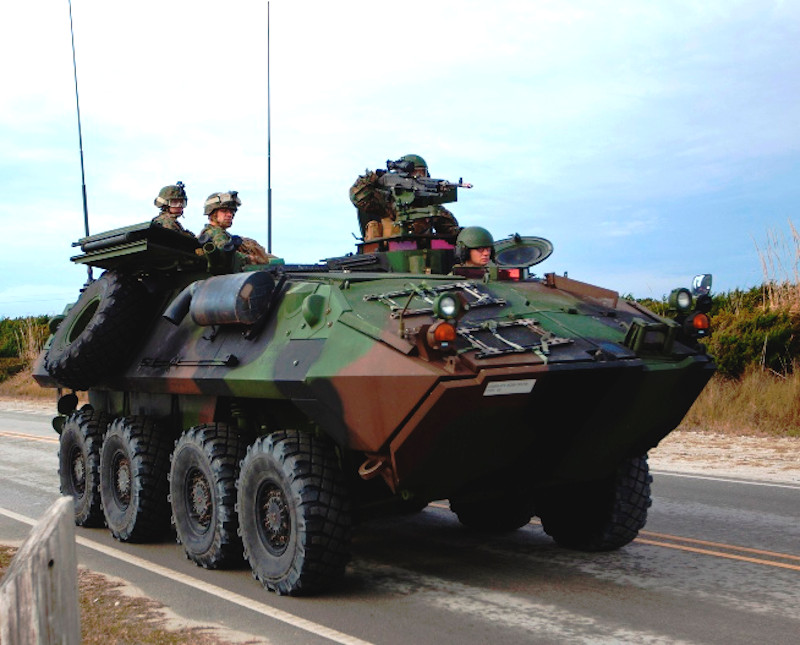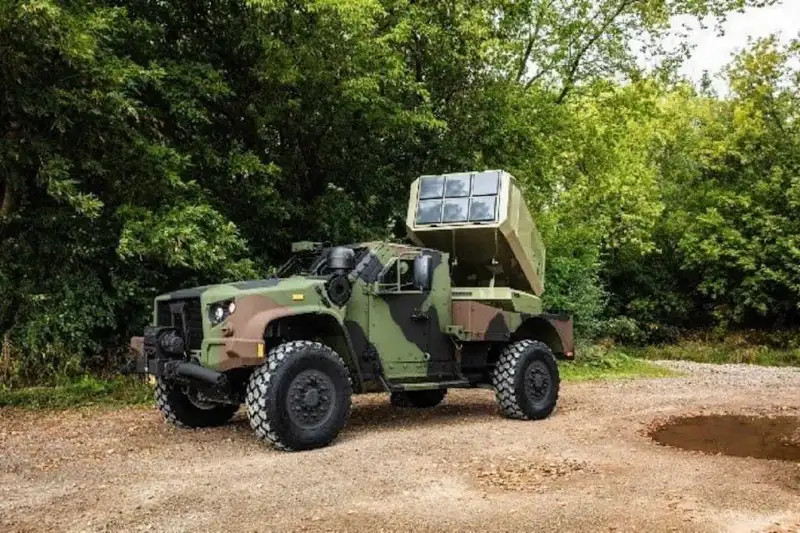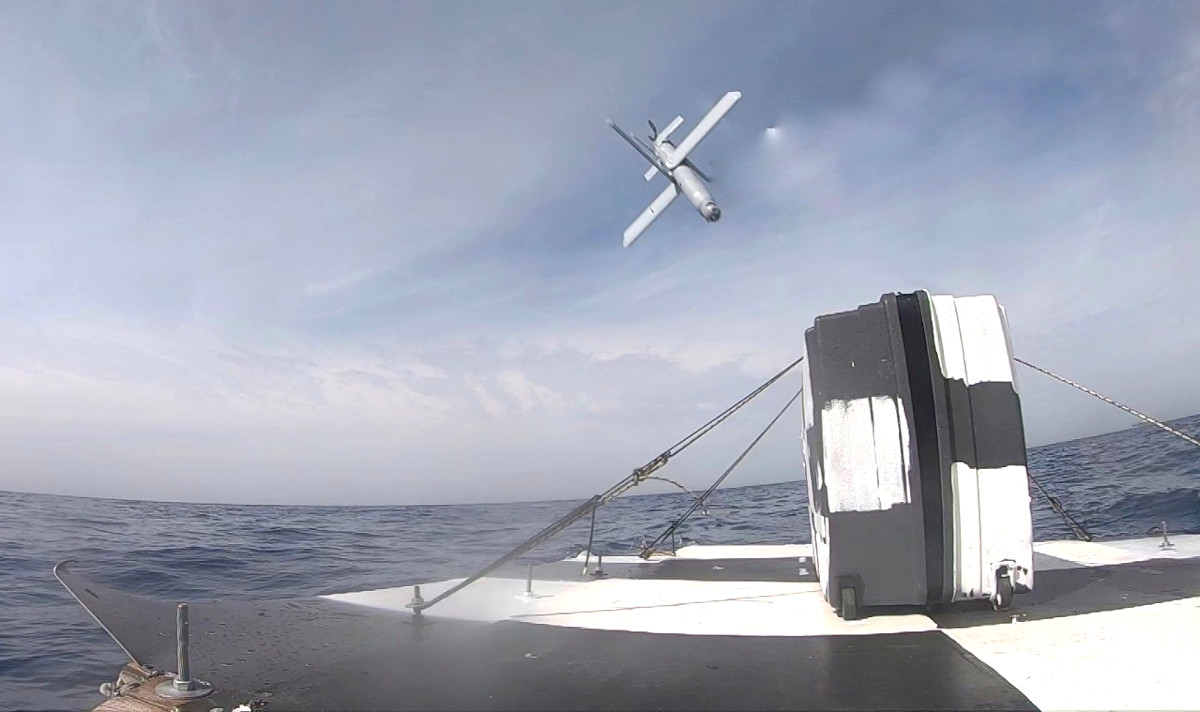The U.S. Marine Corps plans to arm variants of its 8×8 LAV-25 wheeled armored vehicle, as well as 4×4 Joint Light Tactical Vehicles and Long-Range Unmanned Surface Vehicle drone boats with Israeli-designed loitering munitions, sometimes referred to as “suicide drones.” All of these platforms will deploy these munitions, a variant of the UVision Hero-120, from a common Multi-Canister Launcher against various ground and maritime targets.
UVision confirmed that a version of its Hero-120, as well as its Multi-Canister Launcher, had been selected as the winning entry for the Marine Corps’ Organic Precision Fires-Mounted (OPF-M) program on June 21, 2021. Israel-headquartered UVision, which also has its own U.S. subsidiary, is working together with Maryland-based Mistral, Inc. to deliver the Marine-specific Hero-120s, which the latter company has referred to as Loitering Strike Munitions. The broader OFP program, which dates back to at least 2018, also includes plans to acquire smaller, man-portable loitering munitions for dismounted use.

“We are proud to be selected by the Marines to provide advanced solutions for the US frontline forces” Avi Mizrachi, CEO of UVision and a retired Israel Defense Forces Major General, said in a statement on June 21. “The contract is a testament of our customers’ strong belief in our systems and their impressive technical performance. Our subsidiary, UVision USA, is in a process of establishing our US based production facility to support the USMC OPF-M program.“
“Mistral is privileged by the USMC selection of our solution for the OPF-M program,” the President of Mistral, identified only as Ms. Banai, said in a separate statement on June 17. “Mistral and our teammates are honored to provide our Warfighters with the OPF mission-critical precision strike systems.”
It’s not clear how Marines’ Loitering Strike Munition differs from the standard Hero-120 and how substantial the distinction between the two actually is. The Hero-120 is the largest suicide drone in UVision’s “Tactical” product line, weighing in at around 27 and a half pounds, including a high-explosive warhead that is just under 10 pounds.
The Hero-120 is powered by an electric motor running a single propeller at the rear of the munition and can stay aloft for up to an hour. UVision says that the weapon’s maximum range is just under 25 miles when using a line-of-sight control system. Beyond-line-of-sight data links are also available for the Hero-120.
A “man-in-the-loop” control system allows the operator to “see” what the drone sees through the electro-optical and infrared cameras in its nose and issue instructions to it, including to strike a target, throughout the course of a mission. In this way, loitering munitions, which Israeli companies pioneered and continue to be world leaders in the development and manufacture of, can perform typically associated with drones or missiles, but not both.

Marines, for instance, could use Hero-120s to scout ahead or surveil specific positions, with the suicide drones then having the option to immediately prosecute any targets that might emerge. These suicide drones, which can be recovered and reused if they complete a mission without engaging a threat, also offer even small units a way to execute indirect precision strikes at targets, including against ones that might be sheltering inside buildings or otherwise hiding behind cover, at extended ranges.
With the control system’s man-in-the-loop functionality, the Hero-120 and other loitering munitions can also achieve an extreme degree of precision, with an actual operator able to make course corrections right up until the moment of impact. This also provides an added margin of safety against inflicting collateral damage, with that same individual more readily able to abort a strike, even very late in the terminal phase of the weapon’s flight, should innocent bystanders emerge nearby.
Employing these munitions from multi-round launchers on vehicles and small boats can only add flexibility, as well as valuable magazine depth. It’s unclear if the launchers the Marines plan to use on the LAV-M mortar carrier variant of the LAV-25, JLTV, and LRUSV will be identical or will simply use a common architecture. UVision’s press release included a picture, seen at the top of this story, of a test launcher with what appeared to 16 cells.

However, in 2019, Oshkosh, the manufacturer of the JLTV, unveiled a six-round launcher concept for the Hero-120 for use on that vehicle, which it had developed in cooperation with UVision. It seems very possible, if not probable, that the launchers can be scaled up or down to have more or fewer individual canisters depending on the actual platform they’re installed on.

The installations themselves are also likely to be installed or removed, as desired, with relatively limited effort. With that in mind, it is perhaps interesting to note that Mistral was the company that was responsible for the integration of the advanced Israeli-designed 120mm RMS6-L mortar into the mortar carrier variants of the U.S. Army’s 8×8 Stryker wheeled armored vehicle. You can read more about that weapon, which Mistral also helped develop into a turreted base-defense weapon for U.S. special operations forces, here.
The planned integration of the Marine version of the Hero-120 onto the LRUSV is also particularly notable. In January, the Marine Corps hired Metal Shark, a Louisiana-headquarter shipbuilder, to build these drone boats, which the company described as a single “tiered, scalable weapons system [that] will provide the ability to accurately track and destroy targets at range throughout the battle space” and that would be capable, in part, of “transporting loitering munitions to address targets at sea and on land,” in a press release at the time.
The LRUSV program has also been linked to programs within the Pentagon and the Department of the Navy, of which the Marine Corps is a part, that are aimed at giving those unmanned boats the ability to launch swarms of small drones, as well as providing surface swarming capabilities themselves.
The inclusion of the LRUSV, among the other planned future launch platforms for its Hero-120 variants, also makes clear that the Marine Corps sees loitering munitions as a valuable tool for ground and maritime operations, as well as those that span both domains.

The Marine Corps, as a whole, is reforming its entire force structure around new concepts of expeditionary and distributed operations in littoral environments where units, even small ones, might be called upon to engage both naval and ground-based targets in order to help control a particular portion of the battlespace. The service is already exploring how it might employ Javelin anti-tank guided missiles (ATGM) in novel ways in these environments, including firing them from small inflatable boats, as you can read more about in this War Zone feature.

Loitering munitions would also be extremely applicable in the same general scenarios. It’s particularly important to note that, while munitions, such as the Hero-120, may not be capable of outright destroying a warship of any appreciable size, they could still potentially affect a mission kill by destroying or otherwise disabling radars, communications antennas, or other key systems. Depending on the complexity of the systems in question, this could render a ship combat ineffective for a protracted period of time until repairs could be made. Beyond that, as with ATGMs, suicide drones present another option for engaging smaller maritime targets, ranging from landing craft to potentially explosive-laden unmanned boats. UVision and Mistral are not the only companies that are marking suicide drones for use in the naval arena.
The Marines are not the only ones within the U.S. military that are interested in the capabilities that loitering munitions have to offer, either. The U.S. Army, in particular, is working to develop various loitering munitions, primarily for air-launched applications, but which could also be employed using ground-based launchers. The service revealed after one recent test that at least one of these systems was a joint effort, indicating interest in that still-classified design from other branches. In March, Northrop Grumman also announced that it had partnered with UVision and that they were developing a hybrid of the Hero-120 and Hero-400 loitering munition designs to meet the Army requirements.
In its press release about the Marine Corps’ OPF-M program, Mistral also mentioned in passing the development of another version of the Hero-120, known as the Hero-120SF, for U.S. special operations forces. UVision first disclosed it was working on that version, which also differs in unclear ways from the standard variant, last year in response to unspecified U.S. military requirements.
Loitering munitions, as well as missiles with man-in-the-loop control systems, are already seen increasing use in combat around the world. Suicide drones, especially the Israeli-made Harop, were particularly notable components of the brief war between Azerbaijan and Armenia last year. Their use prompted major discussions within military and national security circles, including the U.S. military itself, about the growing significance of these weapons, as well as other unmanned platforms, in current and future conflicts.
All told, the Marine Corps’ planned adoption of a version of the Hero-120, as well as a modular launch system, is just one part of larger and still growing push to field loitering munitions across the U.S. military.
Contact the author: joe@thedrive.com
